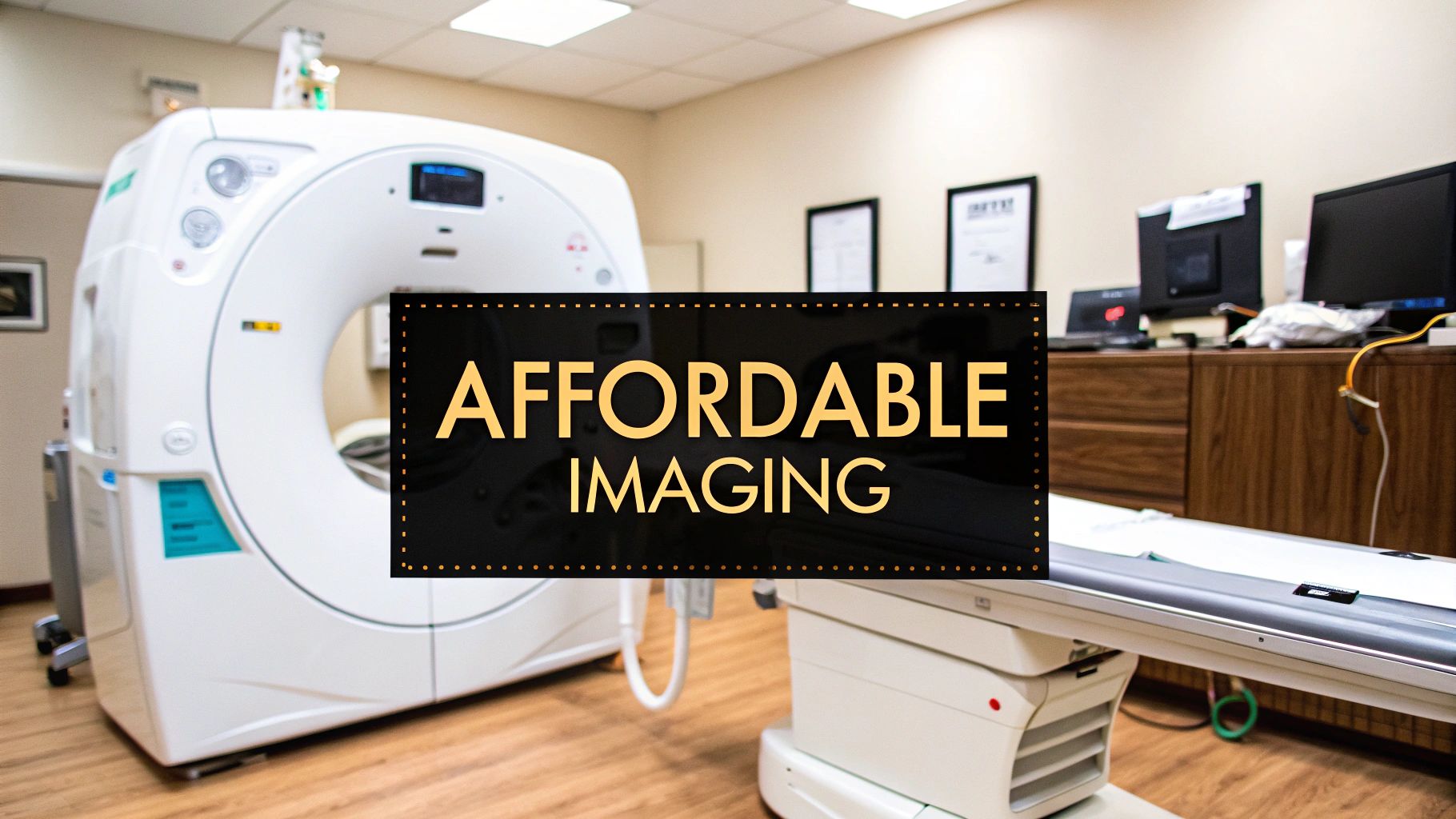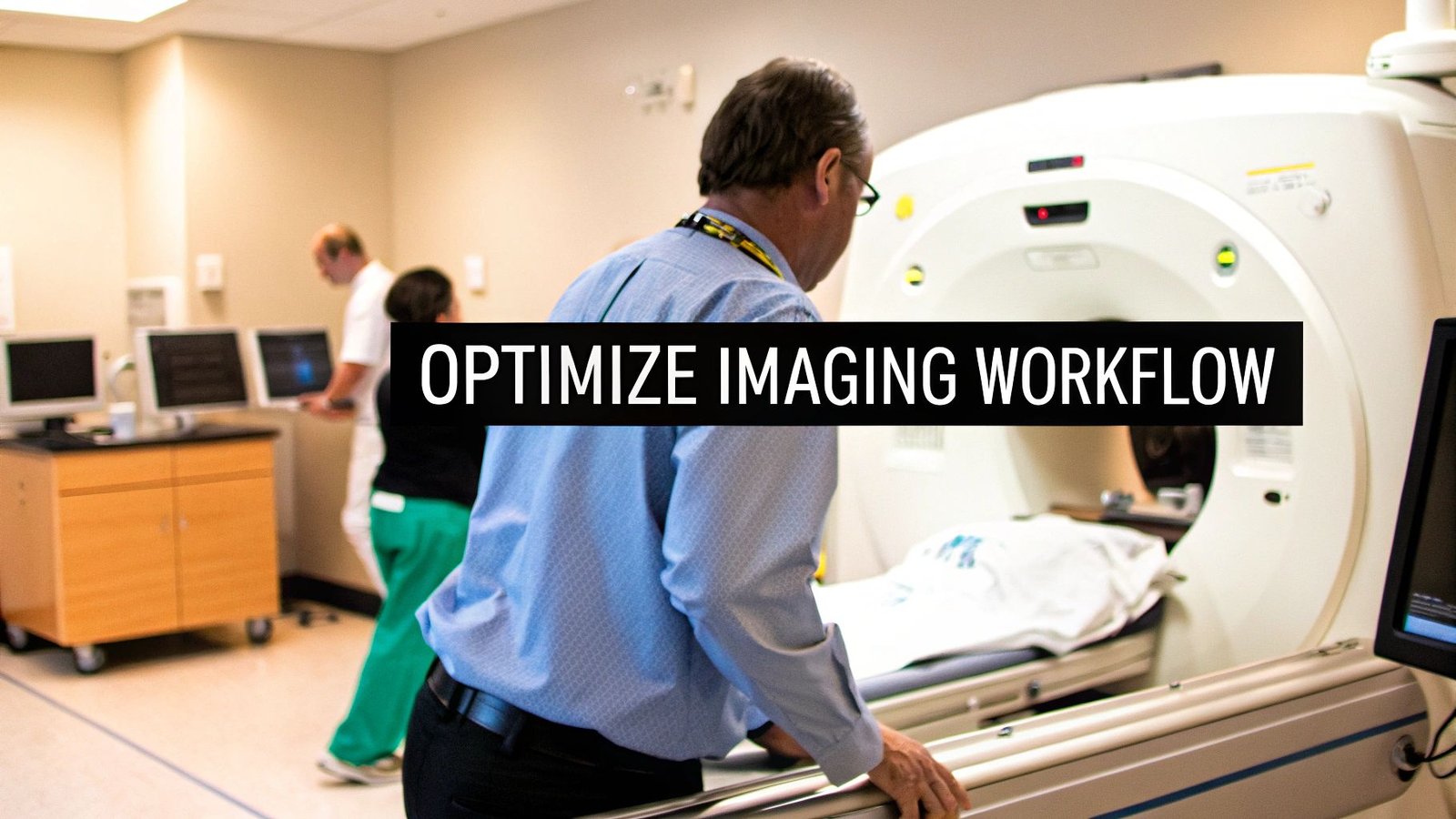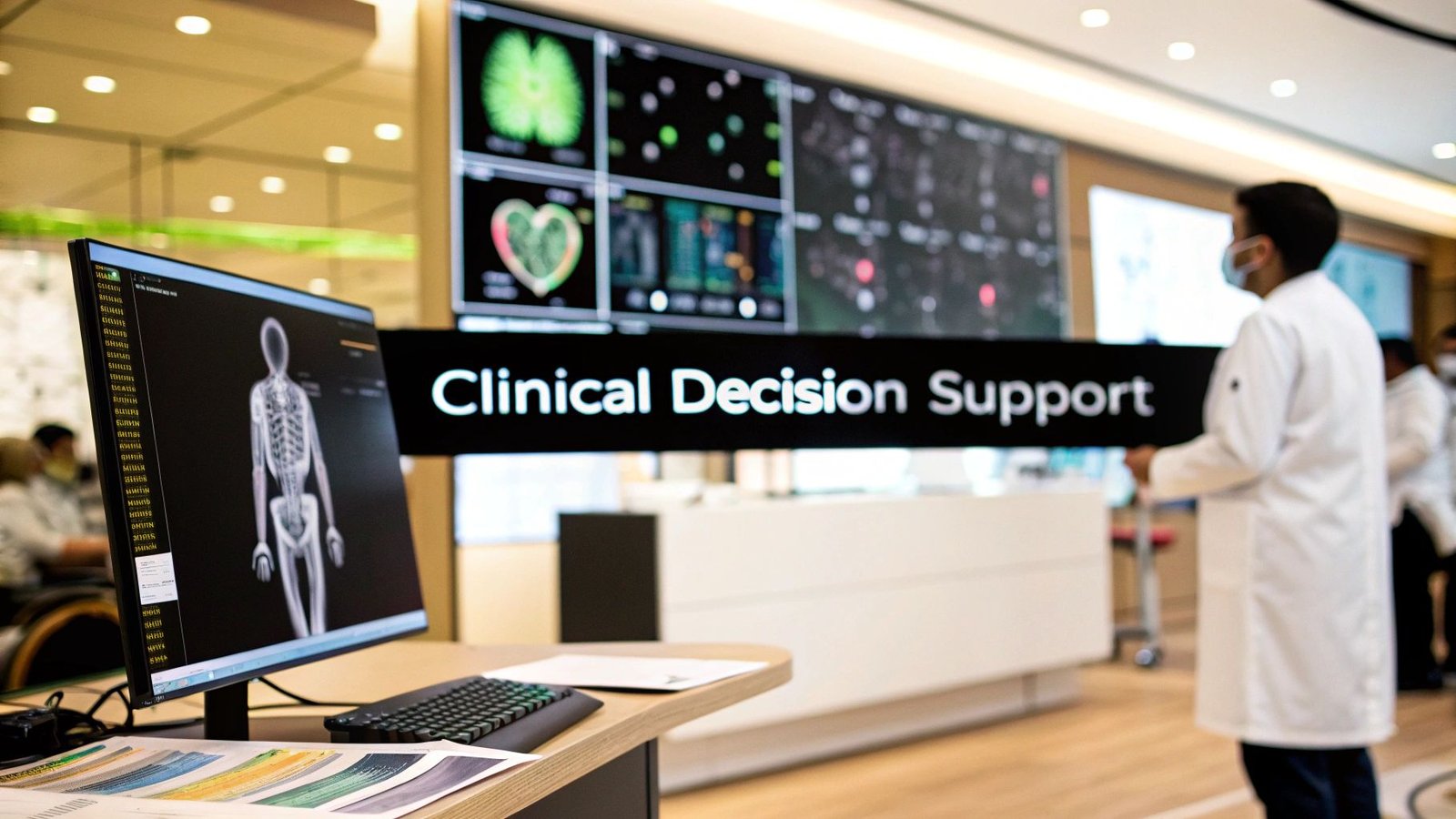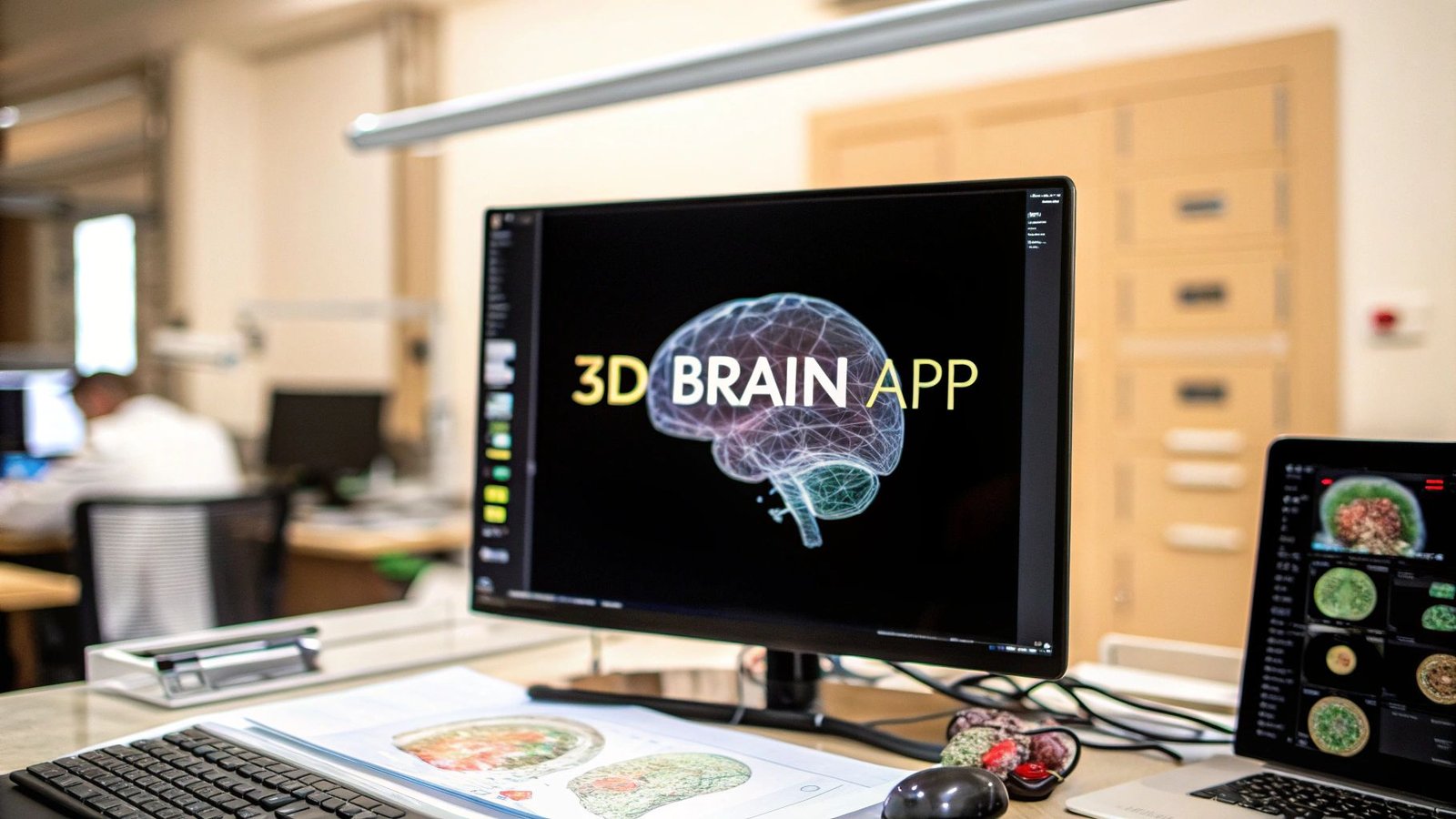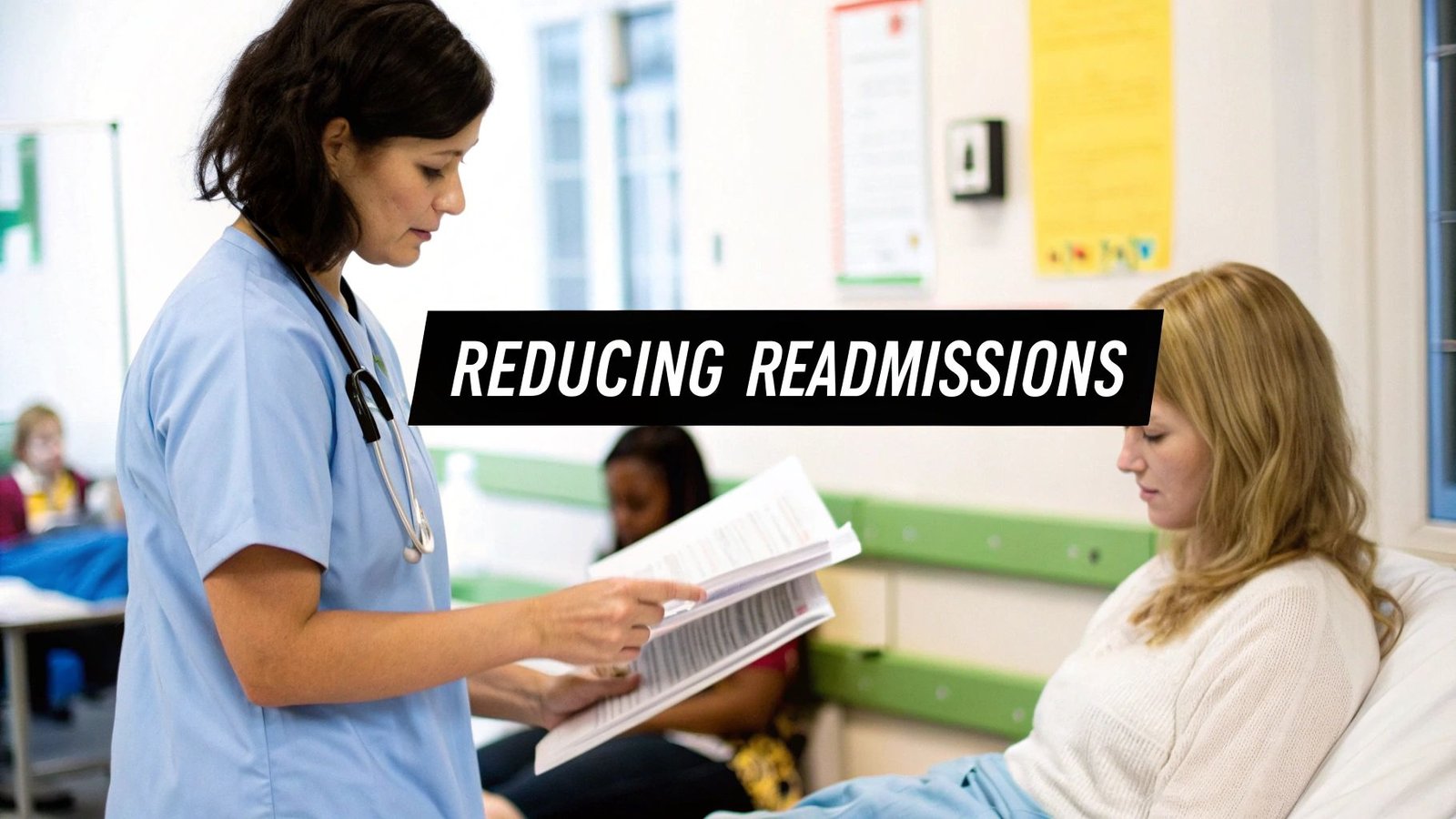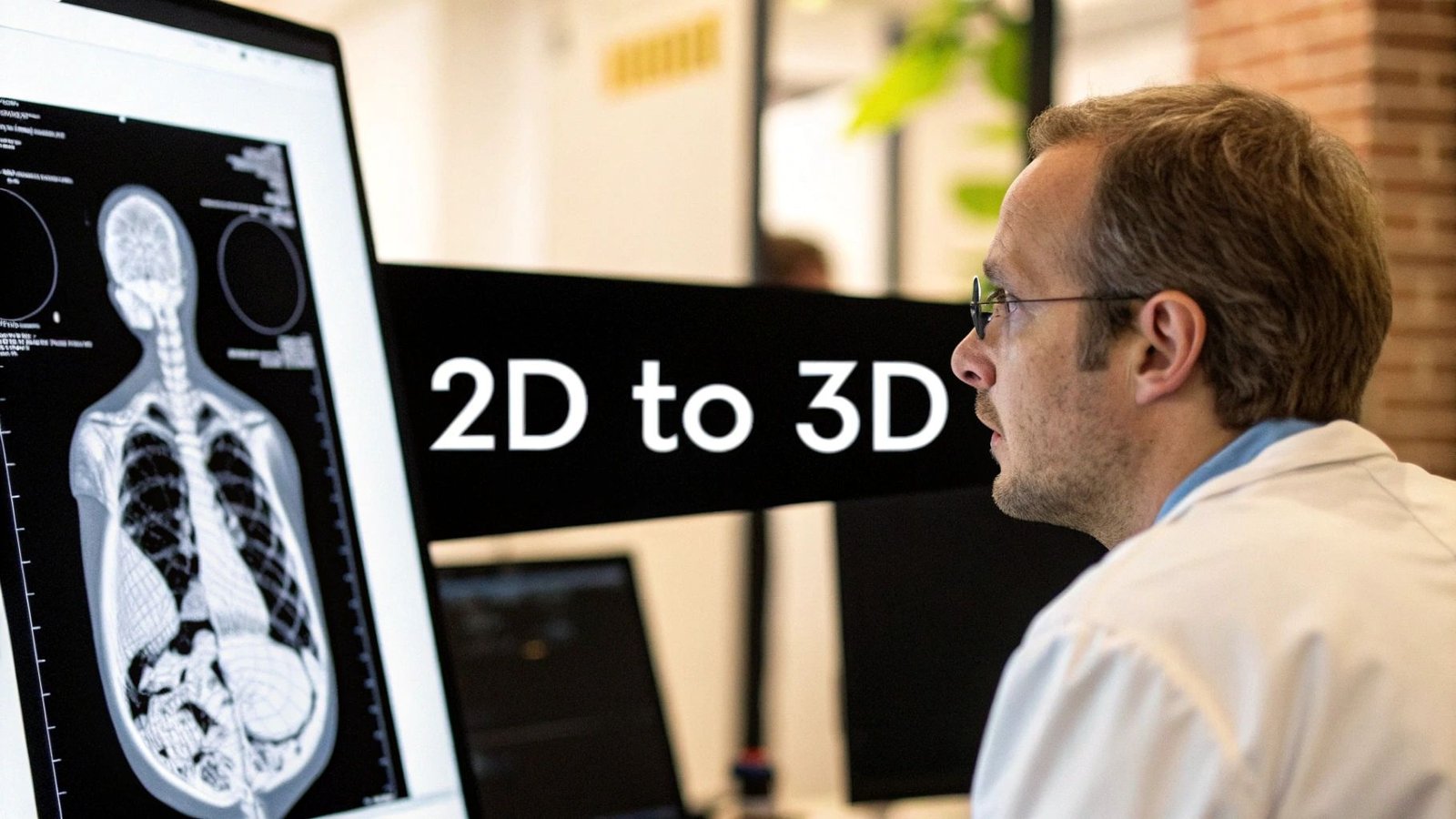Access to affordable medical imaging isn't just a nice-to-have anymore; it's a fundamental part of modern healthcare. I like to think of tools like MRIs and CT scans as the essential highways for seeing inside the human body. For them to be effective, they have to be open and affordable for everyone, not just a privileged few.
The Urgent Need for Affordable Medical Imaging
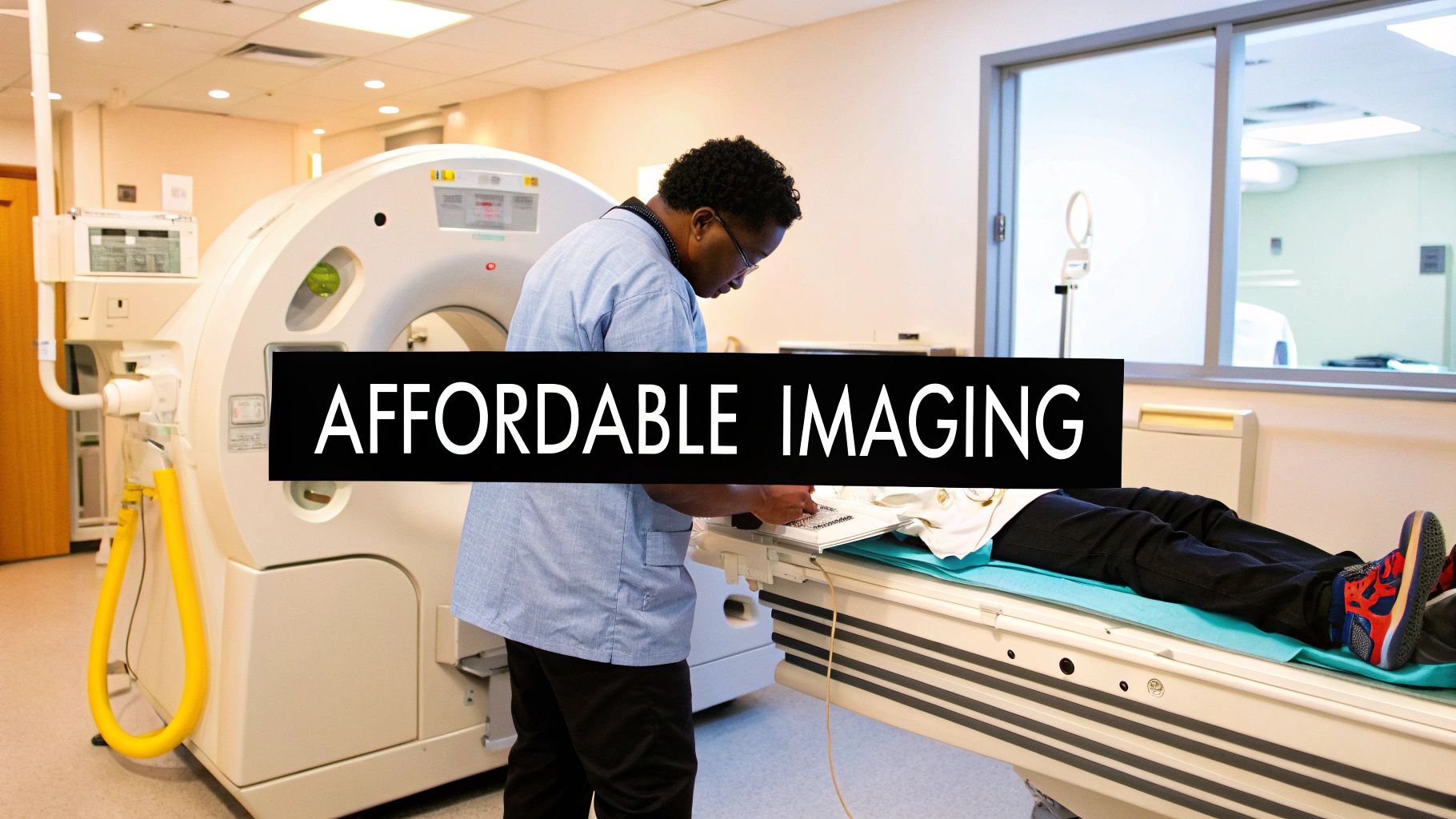
The demand for diagnostic imaging is climbing fast, putting real strain on healthcare systems everywhere. This isn't just a temporary spike. It’s being driven by some powerful, long-term shifts in patient care and clinical needs. Once you understand what’s behind this surge, it becomes crystal clear why making these services more affordable is so critical.
The numbers tell the story. The global medical imaging market was valued at around $63.4 billion in 2023 and is projected to hit $82.6 billion by 2029. That's a steady growth rate of 5.5% each year. This isn't just about more machines; it reflects a deep, growing reliance on these diagnostic tools. For a deeper dive, you can explore more data on the global medical imaging market to see the full picture.
Key Drivers of Demand and Cost
So, what's behind this growing need? Several factors are pushing the demand for more scans while simultaneously making cost a major issue. Two of the biggest culprits are the rise of chronic diseases and a global pivot toward preventative medicine.
- The Rise of Chronic Diseases: Think about conditions like heart disease, cancer, and Alzheimer's. They often require repeated imaging to diagnose the problem, plan treatment, and monitor progress over the long haul. As these illnesses become more common, so does the demand for scans.
- The Shift to Preventative Care: Healthcare is slowly but surely moving away from just treating sickness to actively preventing it. Catching problems early with imaging can save lives and drastically cut down on long-term treatment costs, which makes affordable imaging a cornerstone of modern public health.
The following table breaks down how these factors are pulling the industry in two different directions—pushing demand up while also creating significant cost challenges.
Key Drivers of Medical Imaging Demand and Cost
| Driving Factor | Impact on Demand | Impact on Affordability |
|---|---|---|
| Aging Population | Increases the prevalence of age-related conditions requiring regular scans. | Puts pressure on fixed-income patients and public health budgets. |
| Chronic Diseases | Requires frequent imaging for monitoring and treatment adjustment. | Drives up lifetime healthcare costs for individuals and insurers. |
| Preventative Medicine | Promotes early screening for at-risk populations, increasing scan volume. | High upfront costs can be a barrier if not covered by insurance. |
| Technological Advances | New, more detailed imaging techniques create new diagnostic possibilities. | R&D and equipment costs are high, often passed on to patients. |
This table really highlights the core tension in the field. We have more reasons than ever to use these incredible tools, but their cost can quickly become a major barrier.
The dual pressure—more scans needed for both chronic and preventative care—creates a critical challenge. If the "highways" of diagnostic imaging are too expensive, they become roadblocks to effective healthcare, delaying diagnoses and worsening outcomes.
The real challenge, then, is figuring out how to meet this skyrocketing demand without bankrupting patients or the healthcare system itself. The answer isn't to ration care or use less imaging. It's about making the entire process smarter, more efficient, and fundamentally more affordable. This guide will walk you through the strategies and technologies that are making that possible.
So, What Really Makes Medical Imaging "Affordable"?
When we talk about "affordable" medical imaging, what are we actually saying? It’s easy to think it just means a lower price tag, but the reality is much more nuanced. Think about buying a car. The sticker price is just the beginning; the real cost includes gas mileage, insurance premiums, and future maintenance. True affordability is about the total picture, not just the initial hit to your wallet.
In the world of medical imaging, this same principle applies. Genuine affordability is a careful balance. It's about looking at the upfront cost of the scan, sure, but also the provider's long-term operational expenses and, most importantly, the overall value that scan delivers. An affordable medical imaging service isn't about cutting corners; it's about removing financial roadblocks for everyone—patients and providers alike—without ever compromising diagnostic quality.
Peeking Under the Hood: The Cost Components
So how do imaging providers actually lower the cost of a scan? It’s not about magic or taking shortcuts. It’s about smart, structural changes that create efficiencies, and those savings get passed along to you. Picture a well-oiled machine where every gear turns smoothly, making the whole operation less expensive to run.
Three big factors are at the heart of making imaging more accessible:
- The Type of Facility: Where you get your scan done makes a huge difference. Hospitals have massive overhead costs to cover everything from the ER to a huge administrative staff. Stand-alone outpatient imaging centers don't have that baggage, so they can often offer the exact same scan for much less.
- How Equipment is Sourced: A brand-new, top-of-the-line MRI or CT machine costs a fortune. Many forward-thinking centers use high-quality, certified refurbished equipment. This gear delivers the same diagnostic power but at a fraction of the initial investment for the provider.
- The Model of Care: There’s a growing shift toward value-based care, which is a fancy way of saying we're focusing on patient outcomes instead of just the number of tests ordered. This encourages smarter, more efficient diagnostic processes that cut out unnecessary costs.
True affordability in medical imaging isn’t about sacrificing quality for a lower price. It’s about optimizing the entire system—smarter facility management, cost-effective technology, and patient-first care models—to bring down costs for everyone.
Outpatient Centers: The Efficiency Champions
Independent outpatient centers are the unsung heroes of affordable medical imaging. Unlike a sprawling hospital that has to juggle an emergency room, multiple departments, and layers of administration, these centers are laser-focused on one thing: imaging.
This specialization is their superpower. It lets them run an incredibly lean operation. With lower overhead and specialized staff, they can produce top-notch scans for a whole lot less. It’s not uncommon for an MRI at an independent center to cost 30-50% less than the identical procedure at a hospital, often using the very same technology. It’s powerful proof that lower prices can stem directly from greater efficiency, not lower standards. For patients, this offers a clear path to getting essential diagnostic tests without facing the sticker shock of hospital pricing.
Proven Strategies for Making Medical Imaging More Affordable
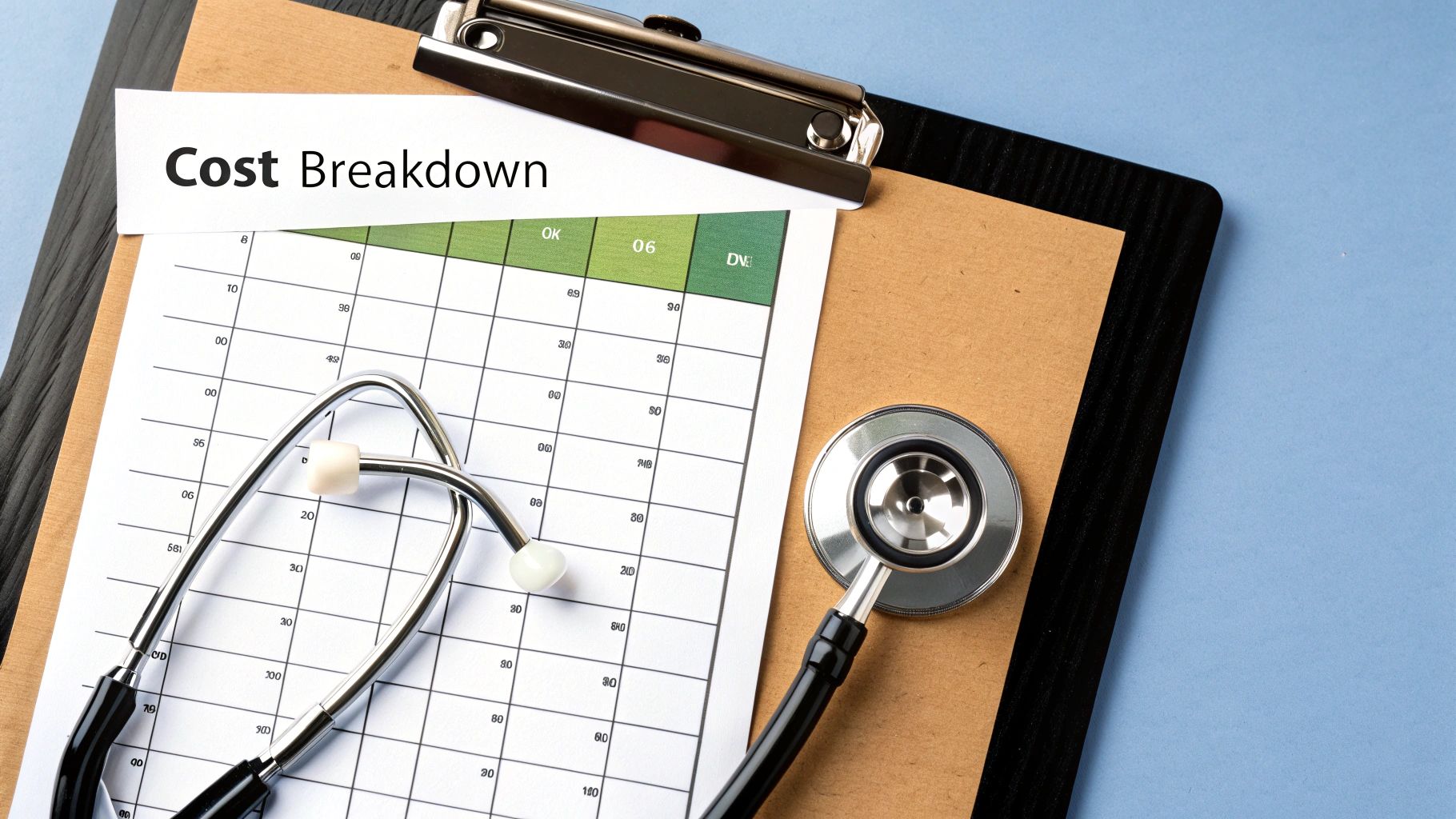
Knowing what affordable medical imaging is is one thing. Seeing how it's achieved is where things get interesting. A handful of proven strategies are already breaking down the financial barriers, making critical diagnostic tests more accessible for everyone involved—from the provider to the patient. These aren't just ideas on a whiteboard; they're real-world solutions in action right now.
These approaches take aim at the biggest cost drivers in the imaging world: staffing, equipment, and facility overhead. By introducing smarter, more efficient ways of working, they help create a system where top-tier diagnostics don’t carry a crippling price tag.
The growth we're seeing in the medical imaging market—from $29.2 billion in 2022 to an estimated $32.2 billion in 2024—is a direct result of these kinds of cost-effective innovations. And it’s not slowing down. Projections show the market hitting $48.8 billion by 2032 as these solutions become the norm. You can explore more of the data if you'd like to read more about these medical imaging statistics and see the trends for yourself.
Embracing Teleradiology for Expert Access
Picture a small clinic in a rural town that needs an expert to look at a complex brain scan. In the past, their options were limited: fly in a specialist or send the patient on a long, stressful journey. Teleradiology changes all of that. Now, that same clinic can digitally send the scan to a top neuroradiologist on the other side of the country—or even the world.
It's a simple concept with a huge impact. By securely transmitting images to an off-site radiologist for interpretation, healthcare facilities unlock two game-changing benefits:
- Reduced Staffing Costs: Clinics no longer need a full-time, on-site radiologist for every possible subspecialty. They can tap into a network of experts on demand, which drastically reduces payroll.
- Faster Turnaround Times: With radiologists available across different time zones, geography is no longer a bottleneck. Scans can be read around the clock, which means a faster diagnosis and a quicker start to treatment for the patient.
Choosing Certified Refurbished Equipment
A shiny new MRI machine can easily cost over a million dollars. That’s a massive investment, and you can bet that cost eventually trickles down to the patient. Thankfully, there’s a smart and reliable alternative: certified refurbished equipment.
Don't mistake this for simply "used" gear. These machines are painstakingly restored by specialized engineers who bring them back to original factory standards.
Think of it like buying a certified pre-owned luxury car. It’s been thoroughly inspected, repaired with genuine parts, and updated to perform like new—all for a fraction of the sticker price.
This approach gives independent clinics and smaller hospitals a fighting chance to offer advanced imaging without taking on crippling debt. They get the same diagnostic power for a much lower operational cost, which is a cornerstone of making affordable medical imaging a widespread reality.
Leveraging Independent Imaging Centers
As we touched on earlier, independent imaging centers are masters of efficiency. Because they operate with much lower overhead than large, sprawling hospitals, they can offer the exact same high-quality scans—like CTs, ultrasounds, and X-rays—at significantly lower prices.
Their focused business model strips away the administrative bloat that often inflates hospital bills. For patients, this translates into more direct, competitive, and transparent pricing for the care they need.
How AI and Technology Drive Down Costs
It’s easy to think of advanced technology as something that only adds to medical bills, but when it comes to medical imaging, technology—especially artificial intelligence (AI)—is actually a huge part of the solution for making diagnostics more affordable. AI isn't some futuristic idea anymore. It's a real-world tool that's already cutting costs and improving efficiency in imaging centers every day.
Think of AI as a highly skilled, incredibly fast assistant working alongside radiologists. It takes on the repetitive, data-heavy tasks, which allows the human experts to focus on what they do best: interpreting complex cases and caring for patients. This partnership is fundamentally changing how imaging facilities operate, creating savings that can be passed directly on to you.
Optimizing Operations With Intelligent Automation
One of the biggest ways AI makes a difference is by untangling and speeding up the day-to-day workflow. For example, integrating tools like medical voice recognition software can dramatically cut down on the time radiologists and staff spend on transcription and paperwork. This alone frees up valuable time and reduces administrative costs.
But the impact goes much deeper, creating a cascade of savings:
- Predictive Maintenance: AI systems can act like a check-engine light for million-dollar MRI and CT scanners. By constantly monitoring the equipment's performance, they can predict when a part might fail before it breaks down. This means centers can schedule routine maintenance instead of facing catastrophic failures, avoiding expensive emergency repairs and the massive financial hit of unexpected downtime.
- Accelerated Image Analysis: AI algorithms can scan through hundreds of images in seconds, flagging potential areas of concern for the radiologist to review. This doesn't replace the doctor's expertise; it supercharges it. The AI does the initial legwork, letting the radiologist focus their trained eye on the most critical parts of the scan, which means they can review more cases each day without sacrificing quality.
- Smarter Scheduling: AI can analyze everything from patient appointment patterns to staff schedules and machine usage. It identifies bottlenecks and inefficiencies that a person might never spot, ensuring that every piece of equipment and every staff member is used as effectively as possible. Less wasted time means lower operational costs.
By handling the time-consuming and repetitive work, AI allows highly trained medical professionals to dedicate their skills to critical thinking and patient interaction. This smart division of labor is a core reason why imaging is becoming more efficient and affordable.
Let's look at how AI's role translates into tangible cost reductions across the board.
The table below breaks down exactly how different AI applications create savings in the medical imaging process.
AI's Impact on Medical Imaging Costs
| AI Application | How It Reduces Cost | Primary Beneficiary |
|---|---|---|
| Workflow Automation | Minimizes manual data entry, scheduling errors, and reporting delays. | Imaging Center Staff |
| Predictive Maintenance | Prevents unexpected equipment failures and costly downtime. | Imaging Center Operations |
| AI-Assisted Diagnostics | Speeds up image review, allowing radiologists to handle more cases. | Radiologists & Patients |
| Intelligent Scheduling | Optimizes use of scanners and staff, reducing idle time. | Imaging Center Management |
As you can see, these AI-driven efficiencies aren't just abstract concepts; they produce measurable results that help lower the overall cost of providing care.
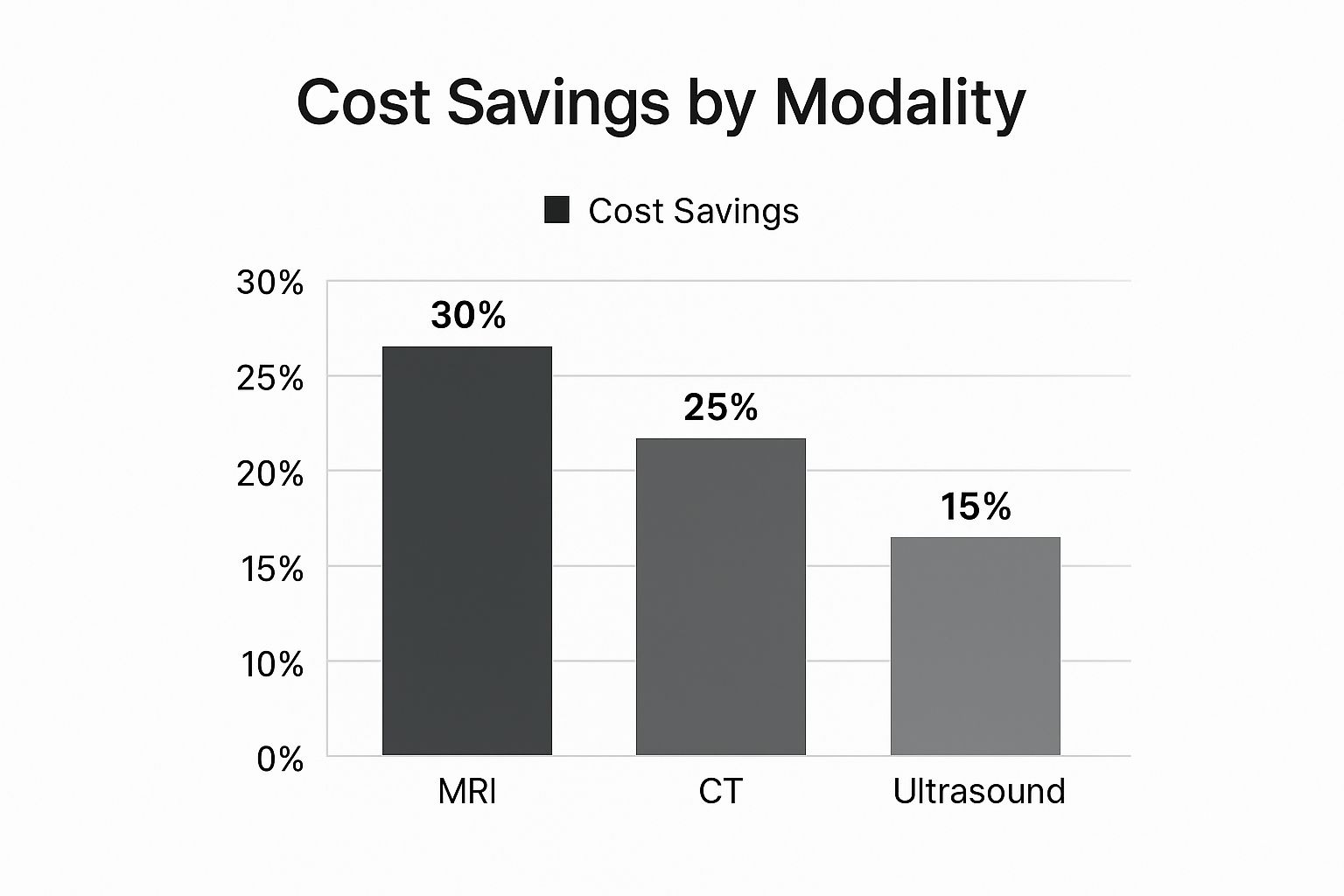
The image above really highlights the impact. The savings are most significant in complex and lengthy procedures like MRIs, where technology's ability to boost efficiency delivers the biggest financial benefits.
The Financial Impact on Providers and Patients
For medical providers, all these improvements lead to a much healthier bottom line. When an imaging center runs more efficiently—with less downtime, lower administrative burdens, and better use of its resources—its operational costs go down significantly.
And here’s the best part: those savings don't just stay with the provider. A financially healthy imaging center can offer more competitive pricing for its services. This is how the promise of affordable medical imaging becomes a reality, making essential diagnostic tests more accessible and easing the financial burden on patients.
Why an Aging Population Makes This Urgent

The drive for affordable medical imaging isn’t just a matter of smart budgeting. It’s a direct response to a massive global shift: our population is getting older. As more people enter their senior years, the frequency of age-related health issues naturally goes up. This isn't some far-off projection; it's a reality that is fundamentally changing healthcare as we speak.
This demographic wave is precisely what makes affordable diagnostics an urgent, non-negotiable priority. It shifts cost-effective imaging from a "nice-to-have" to a cornerstone of public health. The pressure is mounting to find new ways to provide top-tier care without bankrupting healthcare systems or patients.
The Rising Tide of Chronic Conditions
With age comes a higher risk of chronic diseases. Conditions like heart disease, cancer, stroke, and osteoporosis are far more common in older adults. These aren't simple illnesses you treat once; they often require management over many years, sometimes for the rest of a person's life.
Diagnostic imaging is absolutely central to managing these long-term health battles. It’s the tool doctors rely on for:
- Initial Diagnosis: Getting an accurate picture of the problem right from the start.
- Treatment Planning: Using detailed internal views to map out the most effective path forward.
- Ongoing Monitoring: Checking in to see how a treatment is working or if a disease is progressing.
This cycle creates a constant, growing need for scans. For an older population, many of whom are on fixed incomes, the cumulative cost of repeated imaging can quickly become a major obstacle to getting the care they need.
As we get older, our need for diagnostic check-ups naturally increases. The challenge is making sure these essential tools remain accessible and don't become a source of financial hardship for the very people who depend on them most.
The scale of this demographic pressure is enormous. The global population aged 65 and over is projected to nearly double by 2050, reaching approximately 1.6 billion people. This shift is already putting a significant strain on healthcare systems everywhere to deliver imaging solutions that are both effective and affordable. You can discover more about this market pressure from Grand View Research to grasp the full scope of the challenge.
Ultimately, the aging population is the catalyst pushing every cost-saving strategy to the forefront. From teleradiology and refurbished equipment to AI-powered efficiencies, these advancements are critical for building a healthcare model that can sustainably serve an older, more medically complex world.
Common Questions About Affordable Medical Imaging
Let's face it, navigating healthcare costs can be a confusing, and frankly, frustrating experience. So when you hear a term like "affordable medical imaging," it’s completely natural for a few questions—and maybe a healthy dose of skepticism—to pop up. Your health is the most important thing, after all.
This section is here to tackle those common questions head-on. We'll give you clear, straightforward answers to demystify the process, clear up any confusion, and help you feel confident in finding high-quality care that doesn’t break the bank.
Does Affordable Medical Imaging Mean Lower Quality Scans?
This is usually the first and most important question, and the answer is a resounding no. In this context, "affordable" is all about operational efficiency, not cutting corners on diagnostic quality. The savings are found behind the scenes, never at the expense of the actual scan.
Think of it like this: an independent imaging center has much lower overhead than a massive hospital campus. It doesn't have to support an emergency room, a surgical wing, or dozens of other departments. This leaner, more focused structure allows it to charge significantly less for the exact same high-quality MRI or CT scan.
Another way facilities offer savings is by using certified refurbished equipment. These aren't old, clunky machines. They are rigorously tested, recalibrated, and maintained to meet—and often exceed—the original manufacturer's standards. The goal is a smarter process, not a lesser result.
The core principle of affordable imaging is simple: reduce operational waste and administrative bloat to lower the price for patients. Quality and accuracy remain the top priorities.
How Can I Find Affordable Medical Imaging Services Near Me?
Finding these cost-effective options takes a little proactive work, but the potential savings are huge. You have more power as a healthcare consumer than you might realize.
Here are a few practical steps you can take:
- Ask Your Doctor: Your referring physician is a great starting point. Ask them for recommendations for outpatient or independent imaging centers. They’re often familiar with local facilities that offer a great balance of quality and cost.
- Use Price Transparency Tools: Many insurance companies and third-party healthcare websites now offer tools to compare procedure prices. A quick search can reveal staggering cost differences for the same scan at various facilities in your area.
- Call and Ask Directly: Don't be afraid to pick up the phone. Call different imaging centers and ask for their "self-pay" or "cash-pay" price. This rate is often dramatically lower than the price billed through insurance.
Taking these steps puts you in the driver's seat, allowing you to make a choice based on both quality and cost. It’s about finding the best value for your specific needs.
Is AI in Medical Imaging Safe and Reliable for Diagnosis?
Yes, absolutely. It's crucial to understand that AI in medical imaging is designed to be a powerful assistant for the radiologist, not a replacement. These systems are incredibly safe and reliable because their job is to augment human expertise, not automate the final diagnosis. AI algorithms go through strict training and are regulated by bodies like the FDA.
Here's a real-world example: an AI tool can analyze a chest X-ray in seconds and flag a tiny, suspicious nodule that might be difficult for the human eye to spot on a first pass. It then highlights this finding for the radiologist, who applies their expert judgment to review and interpret it.
The AI does the heavy lifting of the initial search, freeing up the radiologist to focus their skills on what matters most: interpretation and making a definitive diagnostic call. The final decision always rests with the trained medical professional, which ensures the highest standard of safety and care.
Can I Use an Independent Center if My Doctor Is with a Hospital?
In almost every case, yes. As the patient, you have the right to choose where your diagnostic imaging is done. Your doctor provides a referral or an order for a specific scan, and you can take that order to any qualified imaging facility you choose.
It’s always a good idea to double-check two things first. Confirm with your insurance provider that the independent center is in-network to get the most out of your benefits. Then, give the center a quick call to ensure they can perform the exact test your doctor ordered. Choosing an independent imaging center is one of the most direct ways you can take control of your own healthcare costs.
At PYCAD, we are at the forefront of developing AI solutions that enhance diagnostic accuracy and operational efficiency, making advanced medical imaging more accessible. Our technology empowers providers to deliver superior care more affordably. Discover how our AI-driven tools are shaping the future of diagnostics at https://pycad.co.
